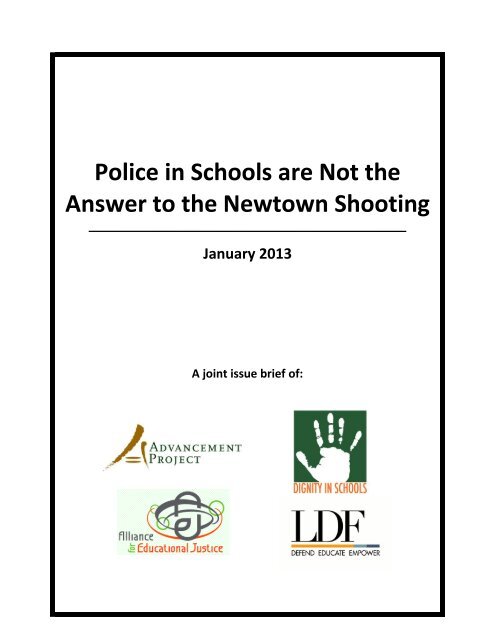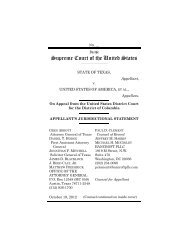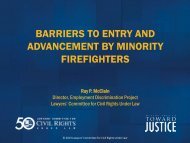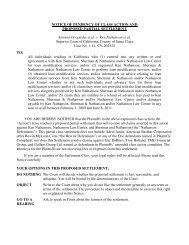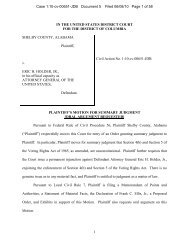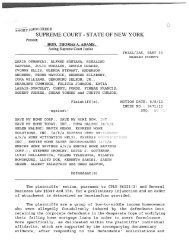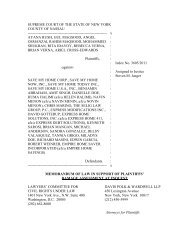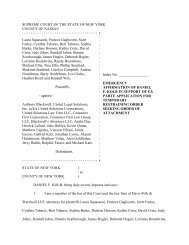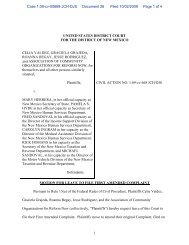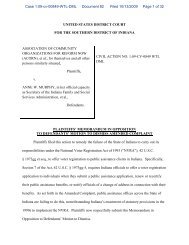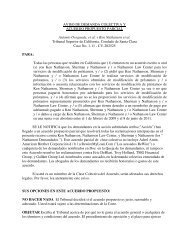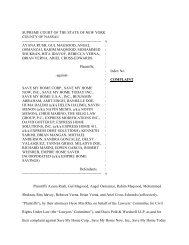Police in Schools are Not the Answer to the Newtown Shooting - Jan ...
Police in Schools are Not the Answer to the Newtown Shooting - Jan ...
Police in Schools are Not the Answer to the Newtown Shooting - Jan ...
- No tags were found...
You also want an ePaper? Increase the reach of your titles
YUMPU automatically turns print PDFs into web optimized ePapers that Google loves.
deploy<strong>in</strong>g <strong>the</strong> National Guard, 3 and arm<strong>in</strong>g every teacher. 4 These proposals satisfy our desire <strong>to</strong> appearsecure. They <strong>are</strong> based on <strong>the</strong> <strong>the</strong>ory that <strong>the</strong> only way <strong>to</strong> keep us safe from guns is <strong>to</strong> have more guns.The New<strong>to</strong>wn tragedy was a shoot<strong>in</strong>g at a school by an outsider, mak<strong>in</strong>g it more ak<strong>in</strong> <strong>to</strong> <strong>the</strong> <strong>in</strong>cidents <strong>in</strong>Aurora and Tucson than past shoot<strong>in</strong>gs at schools by students; but still, <strong>the</strong> responses <strong>to</strong> New<strong>to</strong>wn <strong>are</strong>aimed at do<strong>in</strong>g more <strong>to</strong> “police” our schools. However, when we take a step back and review what weknow about safe schools, we realize that <strong>the</strong>se proposals go more <strong>to</strong>wards creat<strong>in</strong>g <strong>the</strong> appearance ofsafety ra<strong>the</strong>r than <strong>to</strong>wards actually creat<strong>in</strong>g truly safe schools. Mayor Bloomberg of New York City – adistrict that has dealt with <strong>the</strong> consequences of police <strong>in</strong> schools for years 5 – recognizes how <strong>the</strong> <strong>in</strong>fluxof security measures can change school climate. In response <strong>to</strong> learn<strong>in</strong>g about <strong>the</strong> proposals about <strong>the</strong>National Guard and o<strong>the</strong>r measures for <strong>in</strong>creased police <strong>in</strong> schools, he stated, “Oh god that is ridiculous,you can’t live your life that way. You would be <strong>in</strong> a prison.” 6 Mayor Nutter of Philadelphia has alsorejected <strong>the</strong>se proposals as wrong-headed. 7Based on a significant body of research and decades of lived experience, we know that <strong>the</strong>se strategieswill fail. They will do noth<strong>in</strong>g <strong>to</strong> create school environments that reduce violence <strong>in</strong> our communities,catch early <strong>in</strong>dica<strong>to</strong>rs of mental health needs, identify root causes underly<strong>in</strong>g violence, or utilize <strong>the</strong>skills and resources of law enforcement <strong>in</strong> an effective way. They also fail <strong>to</strong> consider <strong>the</strong> host ofun<strong>in</strong>tended consequences – measured <strong>in</strong> educational, emotional, and economic costs – of plac<strong>in</strong>g morepolice <strong>in</strong> schools.Our organizations have worked <strong>to</strong>ge<strong>the</strong>r <strong>to</strong> raise aw<strong>are</strong>ness about <strong>the</strong> devastat<strong>in</strong>g trend known as <strong>the</strong>School-To-Prison Pipel<strong>in</strong>e. Specifically, <strong>to</strong>o many schools <strong>are</strong> employ<strong>in</strong>g policies and practices ofextreme discipl<strong>in</strong>e that push young people out of school and <strong>in</strong><strong>to</strong> <strong>the</strong> juvenile and crim<strong>in</strong>al justicesystem. The <strong>in</strong>flux of police <strong>in</strong> schools has been one of <strong>the</strong> ma<strong>in</strong> contribu<strong>to</strong>rs <strong>to</strong> <strong>the</strong> grow<strong>in</strong>g number ofchildren funneled <strong>in</strong><strong>to</strong> this pipel<strong>in</strong>e.Advancement Project is a next generation, multi-racial civil rights organization, founded <strong>in</strong> 1999 by ateam of veteran civil rights lawyers. We have supported <strong>the</strong> grow<strong>in</strong>g national movement <strong>to</strong> dismantle<strong>the</strong> School-<strong>to</strong>-Prison Pipel<strong>in</strong>e for over thirteen years. Youth, p<strong>are</strong>nts, local groups and <strong>the</strong>ir organizers,o<strong>the</strong>r community leaders, and coalitions have been at <strong>the</strong> forefront of this movement s<strong>in</strong>ce its<strong>in</strong>ception. With our community partners, we have successfully advocated for statewide legislativereform of zero <strong>to</strong>lerance policies and practices, and worked closely with school districts <strong>to</strong> developalternatives <strong>to</strong> crim<strong>in</strong>alization.http://legalclips.nsba.org/?p=17733&utm_source=NSBA+e-newsletter+Subscribers&utm_campaign=c402d5f93a-Legal+Clips+Daily&utm_medium=email.3 S. 3692, 112th Cong. (2012) (known as <strong>the</strong> Save Our <strong>Schools</strong> Act, <strong>in</strong>troduced by Sena<strong>to</strong>r Barbara Boxer, D-Cal).4 National Rifle Association Press Conference, December 21, 2012, http://home.nra.org/#/nraorg/gallery/4.5 See, e.g., New York Civil Liberties Union and American Civil Liberties Union. Crim<strong>in</strong>aliz<strong>in</strong>g <strong>the</strong> Classroom: TheOverpolic<strong>in</strong>g of New York City’s Public <strong>Schools</strong> (March 2007), available at http://www.aclu.org/racialjustice/crim<strong>in</strong>aliz<strong>in</strong>g-classroom-over-polic<strong>in</strong>g-new-york-city-schools.6 Nightl<strong>in</strong>e, Bloomberg Throws Punch at NRA, Obama (December 21, 2012),http://abcnews.go.com/Nightl<strong>in</strong>e/video/nyc-mayor-michael-bloomberg-nra-180416707 Luke Johnson, Michael Nutter: NRA Armed Guard Proposal A 'Completely Dumbass Idea, Huff<strong>in</strong>g<strong>to</strong>n Post: HuffPost Politics (December 26, 2012), http://www.huff<strong>in</strong>g<strong>to</strong>npost.com/2012/12/26/michael-nutternra_n_2366214.html.2
For more than seventy years, <strong>the</strong> NAACP Legal Defense and Educational Fund, Inc. (LDF) has dismantledbarriers <strong>to</strong> access and opportunity and advocated for high quality, <strong>in</strong>clusive education for AfricanAmericans and o<strong>the</strong>r students of color. LDF coord<strong>in</strong>ated <strong>the</strong> legal challenge <strong>to</strong> public schoolsegregation, <strong>in</strong>clud<strong>in</strong>g <strong>the</strong> his<strong>to</strong>ric case Brown v. Board of Education. LDF’s “Dismantl<strong>in</strong>g <strong>the</strong> School <strong>to</strong>Prison Pipel<strong>in</strong>e” <strong>in</strong>itiative is a logical cont<strong>in</strong>uation of this work, address<strong>in</strong>g contemporary obstacles <strong>to</strong>access and <strong>in</strong>clusion that underm<strong>in</strong>e educational opportunity. Capitaliz<strong>in</strong>g upon <strong>in</strong>stitutional expertise<strong>in</strong> both education and crim<strong>in</strong>al justice, LDF staff members engage <strong>in</strong> strategic legal advocacy on schooldiscipl<strong>in</strong>e issues, designed <strong>to</strong> dismantle <strong>the</strong> pipel<strong>in</strong>e <strong>to</strong> prison. And its staff provides leadership <strong>in</strong>several significant national efforts <strong>to</strong> reform school discipl<strong>in</strong>e, <strong>in</strong>clud<strong>in</strong>g <strong>the</strong> Dignity <strong>in</strong> <strong>Schools</strong> Campaign,and <strong>the</strong> School-<strong>to</strong>-Prison Pipel<strong>in</strong>e Legal Strategies Collaborative.The Dignity <strong>in</strong> <strong>Schools</strong> Campaign (DSC) challenges <strong>the</strong> systemic problem of pushout <strong>in</strong> our nation'sschools and advocates for <strong>the</strong> human right of every child <strong>to</strong> a quality education and <strong>to</strong> be treated withdignity. The DSC unites p<strong>are</strong>nts, youth, educa<strong>to</strong>rs and advocates <strong>in</strong> a campaign <strong>to</strong> promote local andnational alternatives <strong>to</strong> a culture of zero-<strong>to</strong>lerance, punishment and removal.The Alliance for Educational Justice (AEJ) is a new national alliance of youth organiz<strong>in</strong>g and<strong>in</strong>tergenerational groups work<strong>in</strong>g for educational justice. AEJ aims <strong>to</strong> br<strong>in</strong>g grassroots groups <strong>to</strong>ge<strong>the</strong>r<strong>to</strong> br<strong>in</strong>g about changes <strong>in</strong> federal education policy, build a national <strong>in</strong>frastructure for <strong>the</strong> educationjustice sec<strong>to</strong>r, and build <strong>the</strong> capacity of our organizations and our youth leaders <strong>to</strong> susta<strong>in</strong> and grow <strong>the</strong>progressive movement over <strong>the</strong> long haul.There is a movement underway around <strong>the</strong> country <strong>to</strong> reduce <strong>the</strong> role of law enforcement <strong>in</strong> schools.The Council of State of Governments (CSG) Justice Center is launch<strong>in</strong>g a national consensus-build<strong>in</strong>gproject that will convene experts <strong>in</strong> such fields as school safety, behavioral health, education, juvenilejustice, social services, law enforcement, and child welf<strong>are</strong>. Youth, p<strong>are</strong>nts, and community partnerswill also play a critical and active role <strong>in</strong> <strong>the</strong> project <strong>to</strong> develop creative solutions. The project isadm<strong>in</strong>istered <strong>in</strong> coord<strong>in</strong>ation with <strong>the</strong> Supportive School Discipl<strong>in</strong>e Initiative launched by At<strong>to</strong>rneyGeneral Eric Holder and Secretary of Education Arne Duncan <strong>in</strong> July 2011, and is supported by apublic/private partnership that <strong>in</strong>cludes <strong>the</strong> Office of Juvenile Justice and Del<strong>in</strong>quency Prevention, NoVoFoundation, The California Endowment, and The Atlantic Philanthropies. 8 Locally, cities and states <strong>are</strong>also tak<strong>in</strong>g steps <strong>to</strong> reduce law enforcement <strong>in</strong>volvement <strong>in</strong> schools. For example, <strong>in</strong> <strong>the</strong> Spr<strong>in</strong>g of 2009,<strong>the</strong> New York City Council began implement<strong>in</strong>g <strong>the</strong> Student Safety Act – a law developed by a coalitionof community organizations who wanted <strong>the</strong> City <strong>to</strong> provide demographic and o<strong>the</strong>r data on studentsuspensions, expulsions, and arrests. Denver Public <strong>Schools</strong> is <strong>in</strong> <strong>the</strong> process of improv<strong>in</strong>g its<strong>in</strong>tergovernmental agreement with <strong>the</strong> police department <strong>to</strong> ensure that <strong>the</strong> role of law enforcement <strong>in</strong>schools is limited. Community organizations have worked with officials <strong>in</strong> Los Angeles <strong>to</strong> move awayfrom ticket<strong>in</strong>g youth who were late <strong>to</strong> school and <strong>to</strong>ward a non-punitive approach <strong>to</strong> attendance issues.And, <strong>in</strong> December 2012, Sena<strong>to</strong>r Durb<strong>in</strong> of Ill<strong>in</strong>ois held <strong>the</strong> first-ever Congressional hear<strong>in</strong>g on <strong>the</strong>School-To-Prison Pipel<strong>in</strong>e. Any proposal <strong>to</strong> place more armed personnel <strong>in</strong> school would represent asignificant departure from <strong>the</strong> national trend.Increas<strong>in</strong>g police presence <strong>in</strong> our schools is not <strong>the</strong> answer <strong>to</strong> <strong>the</strong> tragedy <strong>in</strong> New<strong>to</strong>wn or <strong>to</strong> o<strong>the</strong>r actsof violence. We have seen <strong>in</strong>creased police presence lead<strong>in</strong>g <strong>to</strong> high numbers of youth – particularly8 Justice Center: Council of State Governments, http://justicecenter.csg.org/resources/juveniles (accessed on<strong>Jan</strong>uary 9, 2013).3
youth of color, students with disabilities, lesbian, gay, bisexual, transgender, and queer (LGBTQ)students, and gender non-conform<strong>in</strong>g students – be<strong>in</strong>g arrested for m<strong>in</strong>or and trivial misbehaviors. Wehave seen young people who <strong>are</strong> pushed out of schools by hostile and prison-like school cultures. Wehave seen time, energy, and resources devoted <strong>to</strong> <strong>the</strong> crim<strong>in</strong>alization, not <strong>the</strong> education, of youngpeople. 9The New<strong>to</strong>wn tragedy will be forever impr<strong>in</strong>ted <strong>in</strong> our m<strong>in</strong>ds, and <strong>the</strong>re is no simple solution <strong>to</strong> prevent<strong>the</strong>se tragedies, whe<strong>the</strong>r at a school, a mall, a place of worship, or at a <strong>the</strong>ater. This brief is not <strong>are</strong>sponse <strong>to</strong> <strong>the</strong> shoot<strong>in</strong>g <strong>in</strong> New<strong>to</strong>wn, but ra<strong>the</strong>r <strong>to</strong> those who <strong>are</strong> call<strong>in</strong>g for more police and moreguns as a result. It draws on our collective experience and academic research <strong>to</strong> expla<strong>in</strong> why police <strong>in</strong>schools <strong>are</strong> not <strong>the</strong> answer <strong>to</strong> reduc<strong>in</strong>g violence <strong>in</strong> our communities and classrooms, <strong>to</strong> shed light on <strong>the</strong>un<strong>in</strong>tended consequences of plac<strong>in</strong>g more police <strong>in</strong> our schools, and <strong>to</strong> recommend what steps shouldbe taken <strong>to</strong> ensure that all young people <strong>are</strong> safe <strong>in</strong> <strong>the</strong>ir schools.I. Don’t Let His<strong>to</strong>ry Repeat ItselfThis is not <strong>the</strong> first time that policymakers have been called upon <strong>to</strong> act <strong>in</strong> response <strong>to</strong> tragedies <strong>in</strong> ourschools. In many Colorado schools, particularly after <strong>the</strong> tragedy at Columb<strong>in</strong>e High School, <strong>the</strong>response <strong>to</strong> valid safety concerns was <strong>to</strong> add more police, security guards, metal detec<strong>to</strong>rs, andsurveillance cameras <strong>to</strong> school. Colorado <strong>in</strong>creased security and police presence <strong>in</strong> schools <strong>in</strong> an effort<strong>to</strong> make schools safer. As a result, <strong>the</strong> look and feel of many schools has been changed dramatically,becom<strong>in</strong>g less welcom<strong>in</strong>g and more threaten<strong>in</strong>g <strong>to</strong> students. 10 With <strong>the</strong>se changes, Colorado also saw<strong>in</strong>creas<strong>in</strong>g numbers of students arrested <strong>in</strong> school – mostly for m<strong>in</strong>or offenses, as opposed <strong>to</strong> hav<strong>in</strong>g9 See, e.g., Advancement Project, Alliance for Educational Justice and Gay-Straight Alliance Network, Two WrongsDon't Make A Right: Why Zero Tolerance is not <strong>the</strong> Solution <strong>to</strong> Bully<strong>in</strong>g, June 2012, available athttp://b.3cdn.net/advancement/73b640051a1066d43d_yzm6rkffb.pdf (June 2012). Rob<strong>in</strong> L. Dahlberg. ArrestedFutures: The Crim<strong>in</strong>alization of School Discipl<strong>in</strong>e <strong>in</strong> Massachusetts Three Largest School Districts (Spr<strong>in</strong>g 2012),available at http://www.aclu.org/files/assets/maarrest_reportweb.pdf; ACLU of Florida, Advancement Project, andFlorida State Conference of <strong>the</strong> NAACP. Still Haven’t Shut Down <strong>the</strong> School-<strong>to</strong>-Prison Pipel<strong>in</strong>e 6-8 (March 2011),available at http://b.3cdn.net/advancement/be89ef01bcb350c7fc_z5m6btbgo.pdf; Advancement Project. Test,Punish, and Push Out: How “Zero Tolerance” and High-stakes Test<strong>in</strong>g Funnel Youth <strong>in</strong><strong>to</strong> <strong>the</strong> School-<strong>to</strong>-PrisonPipel<strong>in</strong>e 9-12. (<strong>Jan</strong>uary 2010), available at http://b.3cdn.net/advancement/d05cb2181a4545db07_r2im6caqe.pdf;American Civil Liberties Union and ALCU of Connecticut. Hard Lessons: School Resource Officers and School BasedArrests <strong>in</strong> Three Connecticut Towns (November 2008), available athttp://www.aclu.org/files/pdfs/racialjustice/hardlessons_november2008.pdf; Crim<strong>in</strong>aliz<strong>in</strong>g <strong>the</strong> Classroom, supranote 5; Florida State Conference of <strong>the</strong> NAACP, Advancement Project, and NAACP Legal Defense and EducationalFund, Inc., Arrest<strong>in</strong>g Development: Address<strong>in</strong>g <strong>the</strong> School Discipl<strong>in</strong>e Crisis <strong>in</strong> Florida (2006), available athttp://b.3cdn.net/advancement/e36d17097615e7c612_bbm6vub0w.pdf; Advancement Project. Education onLockdown: The Schoolhouse <strong>to</strong> Jailhouse Track 9 (March 2005), available athttp://b.3cdn.net/advancement/5351180e24cb166d02_mlbrqgxlh.pdf; Advancement Project. Derailed! TheSchoolhouse <strong>to</strong> Jailhouse Track. (May 2003), available athttp://b.3cdn.net/advancement/c509d077028b4d0544_mlbrq3seg.pdf; Advancement Project and <strong>the</strong> Civil RightsProject, Harvard University. Opportunities Suspended: The Devastat<strong>in</strong>g Consequences of Zero Tolerance SchoolDiscipl<strong>in</strong>e 13 (July 2002) available at http://b.3cdn.net/advancement/8d91c72205a1b9d955_ujm6bhguv.pdf.10 See Test Punish Push Out, supra note 9.4
weapons, which was <strong>the</strong> type of offense this approach was orig<strong>in</strong>ally <strong>in</strong>tended <strong>to</strong> address. 11 Forexample, between 2000 and 2004, Denver experienced a seventy-one percent <strong>in</strong>crease <strong>in</strong> schoolreferrals <strong>to</strong> law enforcement. 12 The majority of <strong>the</strong> referrals were for m<strong>in</strong>or behaviors like use ofobscenities, disruptive appearance, and destruction of non-school property. Serious conduct, likecarry<strong>in</strong>g a dangerous weapon <strong>to</strong> school, accounted for only 7% of <strong>the</strong> referrals. 13 The school districtpaid, <strong>in</strong> 2002-2003 and 2003-2004, over $1.2 million annually <strong>to</strong> <strong>the</strong> Denver <strong>Police</strong> Department forpolice presence <strong>in</strong> schools. 14 Essentially, <strong>the</strong> District was pay<strong>in</strong>g police <strong>to</strong> respond <strong>to</strong> <strong>in</strong>cidents that used<strong>to</strong> result <strong>in</strong> a call home or a trip <strong>to</strong> <strong>the</strong> pr<strong>in</strong>cipal’s office. A decade after Columb<strong>in</strong>e, <strong>the</strong>se un<strong>in</strong>tendedconsequences persist: between 2007 and 2012, most of <strong>the</strong> referrals <strong>to</strong> law enforcement were fordetrimental behavior, drug violations, "o<strong>the</strong>r" violations of Code of Conduct, and disobedience/defiance– not for serious weapons or o<strong>the</strong>r school safety concerns. 15Recogniz<strong>in</strong>g <strong>the</strong> harmful effects of <strong>the</strong>se policies, for six years Padres y Jóvenes Unidos, a youth andp<strong>are</strong>nt organization, advocated for reforms. F<strong>in</strong>ally, <strong>in</strong> 2008, work<strong>in</strong>g with <strong>the</strong>n-Super<strong>in</strong>tendent (nowU.S. Sena<strong>to</strong>r) Michael Bennett, <strong>the</strong> group successfully secured reforms that dramatically revised <strong>the</strong>discipl<strong>in</strong>e code, abandon<strong>in</strong>g <strong>the</strong> post-Columb<strong>in</strong>e zero <strong>to</strong>lerance policies and practices <strong>in</strong> Denver Public<strong>Schools</strong>. As part of <strong>the</strong> discipl<strong>in</strong>e reform process, <strong>the</strong>re was a specific focus on reduc<strong>in</strong>g police<strong>in</strong>volvement <strong>in</strong> rout<strong>in</strong>e school discipl<strong>in</strong>e matters, which has led <strong>to</strong> reduced referrals <strong>in</strong> recent years. 16Currently, Padres y Jóvenes Unidos is help<strong>in</strong>g <strong>to</strong> put <strong>in</strong><strong>to</strong> place a new <strong>in</strong>tergovernmental agreement <strong>to</strong>even more effectively limit and redirect <strong>the</strong> role of police <strong>in</strong> <strong>the</strong>ir schools. As a result, Denver’s policealready have an appropriately limited role <strong>in</strong> <strong>the</strong> schools and <strong>the</strong> District is on its way <strong>to</strong> mak<strong>in</strong>g agreater impact <strong>in</strong> reduc<strong>in</strong>g school-based arrests and racial disparities <strong>in</strong> those arrests.The huge <strong>in</strong>crease <strong>in</strong> police presence <strong>in</strong> schools is not limited <strong>to</strong> Colorado. Over <strong>the</strong> last two decades,and particularly post-Columb<strong>in</strong>e, police <strong>in</strong> schools and zero <strong>to</strong>lerance policies proliferated throughout<strong>the</strong> county. This phenomenon is <strong>the</strong> result of our reaction <strong>to</strong> <strong>in</strong>cidents of highly publicized juvenilecrimes and <strong>the</strong> perception that our schools were gett<strong>in</strong>g more violent – not because schools wereactually more dangerous. 17 As a result police presence <strong>in</strong> our schools has dramatically <strong>in</strong>creased.Accord<strong>in</strong>g <strong>to</strong> <strong>the</strong> U.S. Department of Justice, <strong>the</strong> number of school resource officers <strong>in</strong>creased 38%between 1997 and 2007. 18 The regular presence of school security guards <strong>in</strong>creased 27% between 199911 See Education on Lockdown, supra note 9.12 Id. at 23.13 Id. at 24.14 Id. at 25.15 Colorado Department of Education, 2011-2012 Safety and Discipl<strong>in</strong>e Indica<strong>to</strong>rs. Retrieved on <strong>Jan</strong>uary 9, 2013from http://www.cde.state.co.us/cdereval/rv2012sdi<strong>in</strong>cidents.htm.16 Colorado Department of Education, 2011-2012 Safety and Discipl<strong>in</strong>e Indica<strong>to</strong>rs. Retrieved on <strong>Jan</strong>uary 9, 2013from http://www.cde.state.co.us/cdereval/rv2012sdi<strong>in</strong>cidents.htm.17 See National Center for Education Statistics, Indica<strong>to</strong>rs of School Crime and Safety 2011, Table 2.1: Number ofstudent-reported non-fatal crimes ages 12-18 and rates of crime per 1,000 by location, type of crime, and year,1992 – 2010. http://bjs.ojp.usdoj.gov/content/pub/pdf/iscs11.pdf (accessed on <strong>Jan</strong>uary 9, 2013). The <strong>to</strong>tal rate ofself-reported school-based offenses per 1,000 students fell approximately 79% between 1992 and 2010.18 Bureau of Justice Statistics, Law Enforcement Management and Adm<strong>in</strong>istrative Statistics. “Local <strong>Police</strong>Departments, 2007, 28, available at http://bjs.ojp.usdoj.gov/content/pub/pdf/lpd07.pdf. See also AmandaPetteruti and <strong>the</strong> Justice Policy Institute, Education Under Arrest: The Case Aga<strong>in</strong>st <strong>Police</strong> <strong>in</strong> <strong>Schools</strong> (November5
and 2007. 19 The New York City Department of Education (NYC DOE), for example, turned control ofschool security over <strong>to</strong> <strong>the</strong> New York <strong>Police</strong> Department <strong>in</strong> 1998. 20 All school security is under directcontrol of <strong>the</strong> NYPD and school officials have limited authority when law enforcement <strong>in</strong>tervenes <strong>in</strong>student behavioral <strong>in</strong>cidents. As a result, <strong>the</strong> dist<strong>in</strong>ction between school safety and school discipl<strong>in</strong>e hasbeen blurred. The NYC DOE also implemented <strong>the</strong> Impact <strong>Schools</strong> policy, which created funds for<strong>in</strong>creased police presence, metal detec<strong>to</strong>rs, and security cameras <strong>in</strong> schools that were poorlyresourced. 21 Despite <strong>the</strong> fact that <strong>the</strong> Columb<strong>in</strong>e shoot<strong>in</strong>g <strong>to</strong>ok place <strong>in</strong> a suburban and majority whiteschool, <strong>the</strong> post-Columb<strong>in</strong>e security measures – and <strong>the</strong> result<strong>in</strong>g un<strong>in</strong>tended consequences – weremost keenly felt <strong>in</strong> urban <strong>are</strong>as with a high percentage of students of color, many of whom live <strong>in</strong>concentrated poverty. These <strong>are</strong>as were also home <strong>to</strong> schools and communities who have beenhis<strong>to</strong>rically underfunded, crim<strong>in</strong>alized, politically underrepresented, and socially outcast.Almost fifteen years after Columb<strong>in</strong>e, Colorado has begun <strong>to</strong> revise its position on school safety. Newstatewide legislation, widely supported by <strong>the</strong> legislature, school officials, p<strong>are</strong>nts, and students,recognizes that <strong>the</strong> right approach <strong>to</strong> keep<strong>in</strong>g schools safe is keep<strong>in</strong>g youth <strong>in</strong> school and out of <strong>the</strong>juvenile and crim<strong>in</strong>al justice systems. 22 Perhaps best stated by Sen. L<strong>in</strong>da Newell – <strong>the</strong> legislation’ssponsor from Little<strong>to</strong>n, CO, where Columb<strong>in</strong>e High School is located – “As a result of our zero <strong>to</strong>lerancepolicies, nearly 100,000 students have been referred <strong>to</strong> law enforcement over <strong>the</strong> past decade, and whobenefits from that? …We will soon see more children walk<strong>in</strong>g out of school with a diploma not acrim<strong>in</strong>al record.” 23We have seen what happens when we ramp up police presence and o<strong>the</strong>r security measures <strong>in</strong>response <strong>to</strong> a shoot<strong>in</strong>g or o<strong>the</strong>r violent act. In Colorado, it resulted <strong>in</strong> more students gett<strong>in</strong>g arrestedfor m<strong>in</strong>or misbehaviors, more students be<strong>in</strong>g pushed out of school, and a decl<strong>in</strong><strong>in</strong>g sense of safety <strong>in</strong>schools. These un<strong>in</strong>tended consequences <strong>are</strong> persistent and pervasive – despite efforts by p<strong>are</strong>nts,students, and <strong>the</strong> school district, <strong>the</strong> high arrest rates and racial disparities that resulted from <strong>in</strong>creasedpolice presence and zero <strong>to</strong>lerance policies still exist.We should learn from <strong>the</strong> policy choices made by <strong>the</strong> Colorado legisla<strong>to</strong>rs and school officials – notrepeat <strong>the</strong>m. The lessons from Colorado and elsewhere reveal <strong>the</strong> dangers of misplaced priorities.Increas<strong>in</strong>g police presence <strong>in</strong> schools is simply not <strong>the</strong> answer. When school officials implement policies2011) at 1, available at http://www.justicepolicy.org/uploads/justicepolicy/documents/educationunderarrestfullreport.pdf.19 Petteruti, supra note 18 at 6.20 Crim<strong>in</strong>aliz<strong>in</strong>g <strong>the</strong> Classroom, supra note 9 at 8.21 Id. at 9.22 Senate Committee Passes Bipartisan Bill by Sena<strong>to</strong>rs Newell and Hudak <strong>to</strong> Ensure Student Safety and SuccessToday, March 1, 2012, available at http://coloradosenate.org/home/features/senate-committee-passesbipartisan-bill-by-sena<strong>to</strong>rs-newell-and-hudak-<strong>to</strong>-ensure-student-safety-and-success-<strong>to</strong>day.(“ The result<strong>in</strong>g FairDiscipl<strong>in</strong>e <strong>in</strong> <strong>Schools</strong> Act asks schools <strong>to</strong> develop school discipl<strong>in</strong>e policies that: utilize prevention, <strong>in</strong>tervention,res<strong>to</strong>rative justice, peer mediation, counsel<strong>in</strong>g, and o<strong>the</strong>r constructive discipl<strong>in</strong>ary approaches; determ<strong>in</strong>e whichviolations of <strong>the</strong> code require a referral <strong>to</strong> law enforcement and which <strong>are</strong> better handled with<strong>in</strong> <strong>the</strong> school; andprotect students from harm while deal<strong>in</strong>g with misbehavior <strong>in</strong> a way that provides opportunities for <strong>the</strong>m <strong>to</strong> learnfrom <strong>the</strong>ir mistakes.”)23 Id.6
In April 2012, a k<strong>in</strong>dergartener from Milledgeville, GA was handcuffed and arrested for throw<strong>in</strong>ga tantrum.In 2007, a thirteen-year old from New York was handcuffed and removed from school forwrit<strong>in</strong>g <strong>the</strong> word “okay” on her school desk.In 2008, <strong>in</strong> Chicago, a middle school student was arrested just for walk<strong>in</strong>g past a fight that brokeout after school. The student recognized that <strong>the</strong> arrest changed her entire school experience.“Even though I had good grades, my teachers treated me differently after that. They saw me assomeone who got <strong>in</strong><strong>to</strong> fights and got arrested. They didn’t want <strong>to</strong> let me graduate, eat lunchwith my class, or go on our class trip even though I hadn’t done anyth<strong>in</strong>g. It showed me that <strong>the</strong>world wasn’t fair.” 28In 2008, a student at a Florida school was arrested after authorities said he was "pass<strong>in</strong>g gas".Accord<strong>in</strong>g <strong>to</strong> a report released by <strong>the</strong> Mart<strong>in</strong> County Sheriff's Office, <strong>the</strong> 13-year-old boy"cont<strong>in</strong>ually disrupted his classroom environment" by <strong>in</strong>tentionally break<strong>in</strong>g w<strong>in</strong>d. 29 In Los Angeles, CA, <strong>the</strong> police hand out tickets <strong>to</strong> students – many under <strong>the</strong> age of fourteen –for be<strong>in</strong>g late <strong>to</strong> school. 30These examples <strong>are</strong> <strong>in</strong>dicative of a more systemic problem. 31 The use of law enforcement <strong>in</strong> schools <strong>in</strong>Florida, for example, has resulted <strong>in</strong> 16,377 referrals of students directly <strong>to</strong> <strong>the</strong> juvenile justice systemdur<strong>in</strong>g <strong>the</strong> 2010-2011 school year – an <strong>in</strong>credible average of 45 students per day. 32 Statewide, twothirdsof <strong>the</strong> school-based referrals were for misdemeanors. 33 The crimes? Disruption of a schoolfunction, disorderly conduct, and m<strong>in</strong>or school-yard fights. 34 These data, along with qualitative data,<strong>in</strong>dicate that two-thirds of <strong>the</strong> arrests were unnecessary and that schools were rout<strong>in</strong>ely us<strong>in</strong>g police <strong>to</strong>respond <strong>to</strong> m<strong>in</strong>or misbehaviors, some of which did not even constitute <strong>in</strong>fractions of student discipl<strong>in</strong>ecodes. In Los Angeles, between 2004-2009, 47,000 tickets were issued by <strong>the</strong> Los Angeles <strong>Police</strong>Department and <strong>the</strong> Los Angeles School <strong>Police</strong> Department (LASPD) for truancy alone. An additional37,500 tickets were issued and arrests were made by just LASPD between 2009 and 20011 for all typesof school <strong>in</strong>cidents <strong>in</strong>clud<strong>in</strong>g, for example, truancy, disturb<strong>in</strong>g <strong>the</strong> peace, vandalism and petty <strong>the</strong>ft. 35 InDelaw<strong>are</strong>, dur<strong>in</strong>g <strong>the</strong> 2010-2011 school year, approximately 90% of school arrests were for28 Voices of Youth <strong>in</strong> Chicago Education. The Time for Justice is Always Now: VOYCE Annual Report 2011-2012 5,available at http://library.constantcontact.com/download/get/file/1104628315334-75/VOYCE+2012+report2+(1)+(1).pdf.29 13-Year-Old Student Arrested For "Pass<strong>in</strong>g Gas" In School, The Huff<strong>in</strong>g<strong>to</strong>n Post (NOV. 24, 2008),http://www.huff<strong>in</strong>g<strong>to</strong>npost.com/2008/11/24/13-year-old-student-arres_n_146222.html (accessed on <strong>Jan</strong>uary 10,2013).30 The Center for Public Integrity, Los Angeles school police still ticket<strong>in</strong>g thousands of students, available athttp://www.public<strong>in</strong>tegrity.org/2012/12/27/11984/los-angeles-school-police-still-ticket<strong>in</strong>g-thousands-youngstudents.31 See supra note 9 for citations <strong>to</strong> multiple reports document<strong>in</strong>g this phenomenon.32 Florida Department of Juvenile Justice, Del<strong>in</strong>quency <strong>in</strong> Florida’s <strong>Schools</strong>: A Seven Year Study 3 (November 2011)available at http://www.djj.state.fl.us/docs/research2/2010-11-del<strong>in</strong>quency-<strong>in</strong>-schools-analysis.pdf?sfvrsn=0.33 Id. at 8-9.34 Still Haven’t Shut Down <strong>the</strong> School-<strong>to</strong>-Prison Pipel<strong>in</strong>e, supra note 9 at 6-8.35 Data is compiled from records requests submitted <strong>to</strong> <strong>the</strong> LAPD and LASPD and is on file with Community RightsCampaign, http://www.<strong>the</strong>strategycenter.org/project/community-rights-campaign.8
misdemeanors. 36 In Pennsylvania, from 1999-2007, school-based arrests almost tripled. 37 In NorthCarol<strong>in</strong>a, <strong>the</strong>re were over 16,000 school-based referrals <strong>to</strong> <strong>the</strong> juvenile justice system <strong>in</strong> 2008-2009. 38 In2007-2008 <strong>in</strong> Baltimore City Public <strong>Schools</strong>, <strong>the</strong>re were 1,699 arrests and referrals <strong>to</strong> law enforcement. 39Arrests <strong>are</strong> happen<strong>in</strong>g across all ages: <strong>in</strong> Hartford, Connecticut, for example, 86 primary grade studentswere arrested, 25 of who were <strong>in</strong> fourth, fifth, or sixth grade, and 13 who were grade three or below. 40Young people of color <strong>are</strong> disproportionately burdened by this trend. This happens on both <strong>the</strong><strong>in</strong>dividual school and district levels, and on a systemic level. For example, <strong>in</strong> Delaw<strong>are</strong> <strong>in</strong> 2010-2011,Black students were three and half times more likely <strong>to</strong> be arrested <strong>in</strong> school than White students. 41 In2007-2008 <strong>in</strong> Philadelphia, a Black student was three and a half more times likely, and a Lat<strong>in</strong>o studen<strong>to</strong>ne and a half times more likely, <strong>to</strong> be taken <strong>in</strong><strong>to</strong> cus<strong>to</strong>dy from school than a White student. 42 Blackstudents make up only 21% of <strong>the</strong> youth <strong>in</strong> Florida, but were <strong>the</strong> subject of 46% of all 2011 schoolrelatedreferrals <strong>to</strong> law enforcement. 43 In East Hartford, Connecticut <strong>in</strong> <strong>the</strong> 2006-2007 school year,Black and Lat<strong>in</strong>o students were 69% of <strong>the</strong> population, but experienced 85% of school based arrests. 44In West Hartford, Connecticut, Black and Lat<strong>in</strong>o students made up 24% of <strong>the</strong> population, butexperienced 63% of <strong>the</strong> arrests. 45 In addition <strong>to</strong> disparities <strong>in</strong> <strong>in</strong>dividuals schools or districts, across <strong>the</strong>country schools with large populations of students of color <strong>are</strong> more likely <strong>to</strong> rely on zero <strong>to</strong>lerancepolicies and have a significant police presence <strong>in</strong> school. 46 As a result, it is not uncommon for <strong>the</strong> samebehavior that triggers little <strong>to</strong> no response <strong>in</strong> many predom<strong>in</strong>ately White communities <strong>to</strong> result <strong>in</strong>severe consequences <strong>in</strong> communities of color. 47 S<strong>to</strong>ries from <strong>the</strong> ground <strong>in</strong>dicate that <strong>the</strong> same36 Chief Judge Chandlee Johnson Kuhn, Family Court of <strong>the</strong> State of Delaw<strong>are</strong> and Kerr<strong>in</strong> C. Wolf, Doc<strong>to</strong>ralCandidate, School of Public Policy and Adm<strong>in</strong>istration, University of Delaw<strong>are</strong>, Fight<strong>in</strong>’ and Fuss<strong>in</strong>’: An Exam<strong>in</strong>ationof School Arrests, Adjudications, and Dispositions <strong>in</strong> Delaw<strong>are</strong> (presentation on file with <strong>the</strong> authors).37 Test, Punish, Push Out, supra note 9 at 18.38 Id.39 Id.40 Hard Lessons, supra note 9 at 10.41 Fight<strong>in</strong>’ and Fuss<strong>in</strong>’, supra note 36.42 Youth United for Change & Advancement Project. Zero Tolerance <strong>in</strong> Philadelphia: Deny<strong>in</strong>g EducationalOpportunities and Creat<strong>in</strong>g a Pathway <strong>to</strong> Prison 9 (<strong>Jan</strong>uary 2011) available athttp://b.3cdn.net/advancement/68a6ec942d603a5d27_rim6ynnir.pdf. .43 Florida Department of Juvenile Justice, Del<strong>in</strong>quency <strong>in</strong> Florida’s <strong>Schools</strong>: A Seven Year Study 3 (November 2011)available at http://www.djj.state.fl.us/docs/research2/2010-11-del<strong>in</strong>quency-<strong>in</strong>-schools-analysis.pdf?sfvrsn=0.44 Hard Lessons, supra note 9 at 9.45 Id. at 10.46 See Jeremy D. F<strong>in</strong>n and Timothy J. Servoss, Misbehavior, Suspensions, and Security Measures <strong>in</strong> High School:Racial/Ethnic and Gender Differences (2012)(Paper prep<strong>are</strong>d for <strong>the</strong> Clos<strong>in</strong>g <strong>the</strong> School Discipl<strong>in</strong>e Gap: Research <strong>to</strong>Practice national conference <strong>in</strong> Wash<strong>in</strong>g<strong>to</strong>n, D.C., <strong>Jan</strong>. 10, 2013) (f<strong>in</strong>d<strong>in</strong>g students of color were disproportionatelyenrolled <strong>in</strong> schools with high degrees of security <strong>in</strong>clud<strong>in</strong>g presence of police or security guards dur<strong>in</strong>g schoolhours).47 Test, Punish, Push Out, supra note 9 at 15.9
disparities exist <strong>in</strong> arrest rates and <strong>in</strong>teractions with law enforcement for students with disabilities andLGBTQ and gender non-conform<strong>in</strong>g students. 48It is important <strong>to</strong> recognize that <strong>the</strong> <strong>in</strong>creased rates of arrest <strong>are</strong> not a result of students behav<strong>in</strong>g“more badly.” Instead, <strong>the</strong>y appear <strong>to</strong> be a direct result of plac<strong>in</strong>g police <strong>in</strong> <strong>the</strong> schools. A three-yearstudy of numerous schools <strong>in</strong> <strong>the</strong> same district with differ<strong>in</strong>g police presence found that <strong>the</strong> schoolswith police had nearly five times <strong>the</strong> number of arrests for disorderly conduct as schools without apolice presence. 49 In Massachusetts, a study highlighted three demographically similar school districts:one with armed police stationed <strong>in</strong> schools, one with police assigned <strong>to</strong> schools on a rotat<strong>in</strong>g or asneeded basis, and one without police <strong>in</strong> schools. Spr<strong>in</strong>gfield, <strong>the</strong> district with <strong>the</strong> on-site policedepartment, had a significantly higher arrest rate than <strong>the</strong> o<strong>the</strong>r two. 50There <strong>are</strong> significant harms <strong>to</strong> young people attend<strong>in</strong>g schools that over-police. Research shows that afirst-time arrest doubles <strong>the</strong> odds that a student will drop out of high school, and a first-time courtappearance quadruples <strong>the</strong> odds. 51 The American Psychological Association, CSG, and <strong>the</strong> Center forDisease Control and Prevention have all found that extreme discipl<strong>in</strong>e, <strong>in</strong>clud<strong>in</strong>g arrests, predict graderetention, school dropout, and future <strong>in</strong>volvement <strong>in</strong> <strong>the</strong> juvenile and crim<strong>in</strong>al justice systems. 52 As <strong>are</strong>sult, students face last<strong>in</strong>g consequences, not only <strong>in</strong> <strong>the</strong> justice system, but also when apply<strong>in</strong>g forcollege, <strong>the</strong> military, or a job. 53Ra<strong>the</strong>r than mak<strong>in</strong>g students feel safer, plac<strong>in</strong>g police <strong>in</strong> schools often creates a hostile environmentthat breeds distrust. For example, nationwide <strong>in</strong>creases <strong>in</strong> school security and police presence <strong>in</strong> <strong>the</strong>wake of <strong>the</strong> Columb<strong>in</strong>e tragedy have also led <strong>to</strong> <strong>in</strong>creased use of metal detec<strong>to</strong>rs, surveillance cameras,pat-downs, drug-sniff<strong>in</strong>g dogs, and tasers. 54 As students <strong>in</strong> Philadelphia expla<strong>in</strong>ed, <strong>the</strong>se approachescreate “a hostile environment. It makes it seem as though <strong>the</strong>y expect us <strong>to</strong> be negative. I feel violated.I shouldn’t have <strong>to</strong> go through a metal detec<strong>to</strong>r . . . and upon enter<strong>in</strong>g [a particular school for <strong>the</strong> first48 See, e.g. Two Wrongs Don’t Make a Right, supra note 9; Education Under Arrest, supra note 18.49 Education Under Arrest, supra note 18 at 15 (discuss<strong>in</strong>g Mat<strong>the</strong>w Theriot’s “School Resource Officers and <strong>the</strong>Crim<strong>in</strong>alization of Student Behavior,” Journal of Crim<strong>in</strong>al Justice 37 (2009), 280-287).50 Arrested Futures, supra note 9 at 6.51 Gary Sweeten, Who Will Graduate? Disruption of High School Education by Arrest and Court Involvement, 23Justice Quarterly 462, 473-477 (2006).52 See, Skiba, supra note 25; Tony Fabelo et al., Break<strong>in</strong>g <strong>Schools</strong>’ Rules: A Statewide Study of How School Discipl<strong>in</strong>eRelates <strong>to</strong> Students’ Success and Juvenile Justice Involvement (2011); Centers for Disease Control, Health RiskBehaviors among Adolescents Who Do and Do <strong>Not</strong> Attend School – United States, 1992, 43 Morbidity and MortalityWeekly Report, 129 (Mar. 4, 1994). See also Robert Balfanz et al., Sent Home and Put Off-Track: The Antecedents,Disproportionalites, and Consequences of Be<strong>in</strong>g Suspended <strong>in</strong> <strong>the</strong> N<strong>in</strong>th Grade (Dec. 2012) (Paper prep<strong>are</strong>d for <strong>the</strong>Clos<strong>in</strong>g <strong>the</strong> School Discipl<strong>in</strong>e Gap: Research <strong>to</strong> Practice national conference <strong>in</strong> Wash<strong>in</strong>g<strong>to</strong>n, D.C., <strong>Jan</strong>. 10,2013)(f<strong>in</strong>d<strong>in</strong>g that students who were suspended even one time <strong>in</strong> n<strong>in</strong>th grade doubles <strong>the</strong>ir chance dropp<strong>in</strong>g ou<strong>to</strong>f school).53 With respect <strong>to</strong> college access, see Marsha Weissman et al., The Use of Crim<strong>in</strong>al His<strong>to</strong>ry Records <strong>in</strong> CollegeAdmissions (2010) available at: http://www.communityalternatives.org/pdf.Reconsidered-crim<strong>in</strong>al-hist-recs-<strong>in</strong>college-admissions.pdf.54 See, e.g. Derailed! The Schoolhouse <strong>to</strong> Jailhouse Track, supra note 9.10
These experiences can breed widespread resentment, distrust, and hostility among youth, directed at<strong>the</strong> very people charged with keep<strong>in</strong>g <strong>the</strong>m safe. In many cases, <strong>the</strong>se young people may resent be<strong>in</strong>gtreated as crim<strong>in</strong>als; may lose faith <strong>in</strong> <strong>the</strong> goodwill of police when <strong>the</strong>y believe <strong>the</strong>y <strong>are</strong> be<strong>in</strong>g treatedunfairly; and may become antagonistic <strong>to</strong>ward law enforcement <strong>in</strong> response. 65 Problems like <strong>the</strong>secannot simply be solved by more tra<strong>in</strong><strong>in</strong>g for police. Indeed, it is <strong>the</strong> very <strong>in</strong>volvement of police <strong>in</strong>school discipl<strong>in</strong>e that disrupts <strong>the</strong> learn<strong>in</strong>g environment by dim<strong>in</strong>ish<strong>in</strong>g students’ belief <strong>in</strong> <strong>the</strong> legitimacyof school staff authority and by creat<strong>in</strong>g an adversarial relationship between school officials andstudents. 66In addition, plac<strong>in</strong>g more law enforcement <strong>in</strong> schools distracts <strong>the</strong>m from <strong>the</strong>ir role of ensur<strong>in</strong>g safety <strong>in</strong>our schools and <strong>in</strong> our communities. Redirect<strong>in</strong>g police resources <strong>to</strong> schools means that police officersspend more time as school discipl<strong>in</strong>arians and dedicate less time <strong>to</strong> ensur<strong>in</strong>g <strong>the</strong> safety of students and<strong>the</strong> community. As <strong>the</strong> International Association of Chiefs of <strong>Police</strong> noted, “<strong>the</strong> deployment of at least 1officer <strong>to</strong> each of <strong>the</strong> roughly 100,000 schools <strong>in</strong> this nation would result <strong>in</strong> <strong>the</strong> reassignment of nearly1/7th of American law enforcement officers.” 67 Law enforcement should be allowed <strong>to</strong> concentrate<strong>the</strong>ir efforts on prevent<strong>in</strong>g, <strong>in</strong>vestigat<strong>in</strong>g, and respond<strong>in</strong>g <strong>to</strong> crime where it is occurr<strong>in</strong>g. The majority ofviolent crimes aga<strong>in</strong>st youth take place outside of school. The Bureau of Justice Statistics’ Indica<strong>to</strong>rs ofSchool Crime and Safety <strong>in</strong>dicate that, <strong>in</strong> 2010, only a small fraction of all youth homicides occur <strong>in</strong>school, 68 And only a small fraction of youth deaths <strong>are</strong> <strong>the</strong> result of homicides that occur <strong>in</strong> school. 69However, <strong>in</strong>stead of hav<strong>in</strong>g law enforcement personnel devote <strong>the</strong>ir energies <strong>to</strong> what <strong>the</strong>y were tra<strong>in</strong>ed<strong>to</strong> do, which is <strong>to</strong> address serious crim<strong>in</strong>al behaviors that erode public safety and public health, <strong>the</strong>y <strong>are</strong>placed <strong>in</strong> schools where <strong>the</strong>y tend <strong>to</strong> spend valuable time on m<strong>in</strong>or or even trivial offenses. Thiscompromises, ra<strong>the</strong>r than enhances public safety, because time that could be spent address<strong>in</strong>g <strong>the</strong>complex challenges associated with serious crimes is <strong>in</strong>stead spent respond<strong>in</strong>g <strong>to</strong> school behaviors.The consequences of plac<strong>in</strong>g police <strong>in</strong> school <strong>are</strong> <strong>in</strong>credibly high – particularly for youth of color,students with disabilities, gender non-conform<strong>in</strong>g students, and LGBTQ youth. The decision <strong>to</strong> placemore police <strong>in</strong> school must balance <strong>the</strong> valid need for school security with <strong>the</strong> risks and drawbacks ofhav<strong>in</strong>g law enforcement <strong>in</strong> our schools. Here, <strong>the</strong> costs <strong>are</strong> high and <strong>the</strong> ga<strong>in</strong>s <strong>are</strong> m<strong>in</strong>imal: <strong>the</strong>re is noclear correlation between police <strong>in</strong> schools and student safety, and plac<strong>in</strong>g more police <strong>in</strong> schools clearlyharms <strong>the</strong> relationships between youth and adults, <strong>in</strong>creases <strong>the</strong> likelihood that students will bearrested for age-appropriate behaviors, and fails <strong>to</strong> address <strong>the</strong> root causes of violence. The proposals<strong>to</strong> <strong>in</strong>crease <strong>the</strong> police presence <strong>in</strong> schools follow<strong>in</strong>g Sandy Hook is counter<strong>in</strong>tuitive and goes aga<strong>in</strong>steveryth<strong>in</strong>g that we know about <strong>the</strong> best way <strong>to</strong> ensure that youth <strong>are</strong> <strong>in</strong> school communities that <strong>are</strong>supportive, safe, and effective.65 See Jeffrey Fagan & Tom Tyler. Legal Socialization of Children and Adults, 24 Social Justice Research 241-247(2005).66 See Meyer & Leone, supra note 58 at 352; Randall R. Beger, supra note 57 at 340.67 Press Release, International Association of Chiefs of <strong>Police</strong>, Statement of IACP President Craig Steckler onProposal <strong>to</strong> Place Armed <strong>Police</strong> Officers <strong>in</strong> All <strong>Schools</strong> (Dec. 21, 2012)(on file with authors).68 Indica<strong>to</strong>rs of School Crime and Safety: 2011, supra note 17.69 Center for Disease Control, National Center for Injury Prevention and Control,http://webappa.cdc.gov/sasweb/ncipc/leadcaus10_us.html (prep<strong>are</strong>d by Professor Dewey Cornell, Curry School ofEducation, University of Virg<strong>in</strong>ia. All annual <strong>to</strong>tals <strong>are</strong> approximate, us<strong>in</strong>g <strong>the</strong> school year for school homicides and<strong>the</strong> calendar year for non-school data).13
III. Creat<strong>in</strong>g Truly Safe <strong>Schools</strong> & Reduc<strong>in</strong>g ViolenceIncreased security measures at school, such as metal detec<strong>to</strong>rs, surveillance cameras, entry checkpo<strong>in</strong>ts, and police presence, <strong>are</strong> unlikely <strong>to</strong> prevent all school-related shoot<strong>in</strong>gs. Research has foundthat <strong>the</strong> relationships between students, p<strong>are</strong>nts, and staff <strong>are</strong> more important <strong>in</strong> mak<strong>in</strong>g a school safethan <strong>in</strong>creased security measures. 70 We must focus on long-term solutions that will reduce violence andnurture young people by address<strong>in</strong>g root causes and giv<strong>in</strong>g <strong>the</strong>m <strong>the</strong> support and resources <strong>the</strong>y need.Creat<strong>in</strong>g truly safe schools – <strong>in</strong>stead of creat<strong>in</strong>g <strong>the</strong> appearance of safe schools – means tak<strong>in</strong>g steps <strong>to</strong>ensure a positive school climate that is focused on foster<strong>in</strong>g connectedness and communication, and onpromot<strong>in</strong>g practices that have proven <strong>to</strong> be effective, like non-violent conflict resolution and res<strong>to</strong>rativejustice.America’s <strong>to</strong>p researchers on school safety have issued a statement on <strong>the</strong> New<strong>to</strong>wn tragedy. Theyrem<strong>in</strong>d us that students <strong>are</strong> safest <strong>in</strong> schools where <strong>the</strong>y feel connected <strong>to</strong> <strong>the</strong>ir educa<strong>to</strong>rs and <strong>the</strong>irpeers; where youth trust adults enough <strong>to</strong> sh<strong>are</strong> <strong>the</strong> problems <strong>the</strong>y face (be it conflict, depression,bully<strong>in</strong>g, or o<strong>the</strong>r issues) and any fears <strong>the</strong>y may have about safety. 71 As <strong>the</strong> researchers note, federallaw enforcement agencies such as <strong>the</strong> FBI, U.S. Secret Service, and o<strong>the</strong>rs have shown us that <strong>the</strong> bestway <strong>to</strong> prevent many acts of violence targeted at schools is by “ma<strong>in</strong>ta<strong>in</strong><strong>in</strong>g close communication andtrust with students and o<strong>the</strong>rs <strong>in</strong> <strong>the</strong> community.” 72In <strong>the</strong> short term, we should support schools <strong>in</strong> creat<strong>in</strong>g school safety and security plans, <strong>in</strong> tra<strong>in</strong><strong>in</strong>gstudents and adults <strong>to</strong> follow those plans, and hav<strong>in</strong>g relevant professional development for all schoolpersonnel.In <strong>the</strong> long-term, support<strong>in</strong>g and <strong>in</strong>centiviz<strong>in</strong>g conflict resolution programs <strong>in</strong> school <strong>are</strong> key elements ofmak<strong>in</strong>g schools safer. Conflict resolution programs teach how <strong>to</strong> “effectively and peaceably” handleconflict by both address<strong>in</strong>g <strong>the</strong> <strong>the</strong>ory beh<strong>in</strong>d conflict resolution and by putt<strong>in</strong>g <strong>in</strong><strong>to</strong> place a process forstudents and adults <strong>to</strong> resolve problems. 73 Res<strong>to</strong>rative justice is an approach that focuses on <strong>the</strong> needsof victims, offenders, and <strong>the</strong> community by encourag<strong>in</strong>g offenders <strong>to</strong> take responsibility for <strong>the</strong>iractions and repair <strong>the</strong> harm done <strong>in</strong> some way. The direct victims, and any o<strong>the</strong>r affected communitymembers, take an active role <strong>in</strong> <strong>the</strong> process. In practice, res<strong>to</strong>rative justice often takes <strong>the</strong> form ofres<strong>to</strong>rative circles and res<strong>to</strong>rative conferences where <strong>the</strong> community comes <strong>to</strong>ge<strong>the</strong>r <strong>to</strong> explore howeach person has been affected by <strong>the</strong> offense. 74 The International Institute for Res<strong>to</strong>rative Practices70 See, e.g., Mat<strong>the</strong>w Ste<strong>in</strong>berg, Ela<strong>in</strong>e Allensworth and David W. Johnson, Student and Teacher Safety <strong>in</strong> ChicagoPublic <strong>Schools</strong>: The Roles of Community Context and School Social Organization (May 2001), available athttp://ccsr.uchicago.edu/sites/default/files/publications/SAFETY%20IN%20CPS.pdf.71 Dewey G. Cornell et al, A Call for More Effective Prevention of Violence (Dec. 19 2012), available athttp://curry.virg<strong>in</strong>ia.edu/articles/sandyhookshoot<strong>in</strong>g.72 Id. See also United States Secret Service and United States Department of Education, The F<strong>in</strong>al Report andF<strong>in</strong>d<strong>in</strong>gs of <strong>the</strong> Safe <strong>Schools</strong> Initiative: Implications for <strong>the</strong> Prevention of School Attacks <strong>in</strong> <strong>the</strong> United States (May2002), available at http://www.secretservice.gov/ntac/ssi_f<strong>in</strong>al_report.pdf.73 Nad<strong>in</strong>e E. Gardner, Conflict Resolution Programs <strong>in</strong> <strong>the</strong> <strong>Schools</strong>, American Counsel<strong>in</strong>g Association ProfessionalCounsel<strong>in</strong>g Digest (2008), available at http://counsel<strong>in</strong>goutfitters.com/vistas/ACAPCD/ACAPCD-19.pdf.74 See, e.g., International Institute for Res<strong>to</strong>rative Practices, http://www.iirp.edu/what-is-res<strong>to</strong>rative-practices.php(accessed on <strong>Jan</strong>uary 9, 2013).14
found that schools us<strong>in</strong>g res<strong>to</strong>rative justice had decreased <strong>in</strong>cidents of violence, assault, and disorderlyconduct <strong>in</strong> <strong>the</strong>ir schools. 75 These programs, and o<strong>the</strong>r similar evidence-based programs, <strong>in</strong>vest <strong>in</strong>creat<strong>in</strong>g healthy and safe schools and communities.In order <strong>to</strong> support policies and practices that create safe and effective school communities, we urge <strong>the</strong>follow<strong>in</strong>g:1. Do not place more police officers or armed personnel <strong>in</strong> schools.We strongly oppose <strong>the</strong> calls for arm<strong>in</strong>g school teachers, pr<strong>in</strong>cipals, and o<strong>the</strong>rs <strong>in</strong> <strong>the</strong> schoolbuild<strong>in</strong>g. Similarly, we object <strong>to</strong> us<strong>in</strong>g <strong>the</strong> limited resources of <strong>the</strong> federal government <strong>to</strong> expand<strong>the</strong> presence of police <strong>in</strong> schools. More specifically, we oppose <strong>the</strong> legislation offered late lastCongress by Sena<strong>to</strong>r Barbara Boxer <strong>to</strong> facilitate <strong>the</strong> <strong>in</strong>stallation of National Guard troops <strong>in</strong> U.S.schools (S. 3692). We cannot support any such actions that have not been shown <strong>to</strong> make schoolssafer and <strong>in</strong>stead can lead <strong>to</strong> terrify<strong>in</strong>g, fatal mistakes.A plan <strong>to</strong> <strong>in</strong>crease <strong>the</strong> presence of police may also underm<strong>in</strong>e <strong>the</strong> work of both <strong>the</strong> Office for CivilRights and <strong>the</strong> U.S. Department of Education and <strong>the</strong> Civil Rights Division of <strong>the</strong> U.S. Department ofJustice. Dur<strong>in</strong>g <strong>the</strong> Obama Adm<strong>in</strong>istration, <strong>the</strong>se agencies have endeavored <strong>to</strong> dismantle <strong>the</strong>School-To-Prison Pipel<strong>in</strong>e, <strong>in</strong>clud<strong>in</strong>g by challeng<strong>in</strong>g police practices <strong>in</strong> schools. In Oc<strong>to</strong>ber 2012, <strong>the</strong>United States Department of Justice filed suit aga<strong>in</strong>st <strong>the</strong> city of Meridian, <strong>the</strong> County of Lauderdale,two youth court judges, <strong>the</strong> State of Mississippi, and two state agencies for operat<strong>in</strong>g a school-<strong>to</strong>prisonpipel<strong>in</strong>e. 76 The compla<strong>in</strong>t alleges that <strong>the</strong>se ac<strong>to</strong>rs <strong>are</strong> “engag[<strong>in</strong>g] <strong>in</strong> a pattern or practice ofunlawful conduct through which <strong>the</strong>y rout<strong>in</strong>ely and systematically arrest and <strong>in</strong>carcerate children,<strong>in</strong>clud<strong>in</strong>g for m<strong>in</strong>or school rule <strong>in</strong>fractions, without even <strong>the</strong> most basic procedural safeguards, and<strong>in</strong> violation of <strong>the</strong>se children’s constitutional rights.” 772. Provide <strong>in</strong>creased support for best practices <strong>in</strong> improv<strong>in</strong>g school communication andconnectedness.We support <strong>the</strong> teach<strong>in</strong>g of Social and Emotional Learn<strong>in</strong>g practices such as Res<strong>to</strong>rative Justice andPositive Behavior Intervention and Supports. These frameworks enable students <strong>to</strong> develop astronger sense of empathy and compassion for each o<strong>the</strong>r, as well as <strong>the</strong>ir teachers; help get <strong>to</strong> rootcauses of misbehavior and/or conflict; and will lessen <strong>the</strong> chances that students who have serious"problems" will be ignored, <strong>the</strong>reby improv<strong>in</strong>g <strong>the</strong>ir chances of gett<strong>in</strong>g <strong>the</strong> support andunderstand<strong>in</strong>g needed <strong>to</strong> br<strong>in</strong>g <strong>the</strong>m back <strong>in</strong><strong>to</strong> <strong>the</strong> school community. The Res<strong>to</strong>rative Justice <strong>in</strong><strong>Schools</strong> Act (H.R. 415, Cohen) and <strong>the</strong> Positive Behavior for Safe and Effective <strong>Schools</strong> Act (H.R.75 International Institute for Res<strong>to</strong>rative Practices, Improv<strong>in</strong>g School Climate: F<strong>in</strong>d<strong>in</strong>gs from <strong>Schools</strong> Implement<strong>in</strong>gRes<strong>to</strong>rative Practices (2009), available at www.iirp.edu/pdf/IIRP-Improv<strong>in</strong>g-School-Climate.pdf.76 The defendants <strong>in</strong> <strong>the</strong> DOJ’s suit <strong>are</strong> <strong>the</strong> city of Meridian, <strong>the</strong> county of Lauderdale, two youth court judges <strong>in</strong>Lauderdale County, <strong>the</strong> State of Mississippi, <strong>the</strong> Mississippi Department of Human Services, and <strong>the</strong> MississippiDivision of Youth Services. Compla<strong>in</strong>t filed <strong>in</strong> U.S. District Court Sou<strong>the</strong>rn District of Mississippi (Oct. 24, 2012),Case: 4:12-cv-00168-HTW-LRA, United States of America v. City of Meridian, et. al., available athttp://www.justice.gov/crt/about/spl/documents/meridian_compla<strong>in</strong>t_10-24-12.pdf.77 Id. at 1.15
3165, Davis/Platts) both direct federal support for tra<strong>in</strong><strong>in</strong>g schools and teachers <strong>in</strong> <strong>the</strong>se bestpractices. The Successful, Safe, and Healthy Students Act (S. 919, Hark<strong>in</strong>) would use school data onbully<strong>in</strong>g, harassment, and discipl<strong>in</strong>e <strong>to</strong> target support for implement<strong>in</strong>g <strong>the</strong>se best practices as well.3. Support <strong>the</strong> development of comprehensive local or regional strategies <strong>to</strong> improve studentsafety while reduc<strong>in</strong>g <strong>the</strong> number of youth enter<strong>in</strong>g <strong>the</strong> justice system.Congress and <strong>the</strong> adm<strong>in</strong>istration should promote expanded educational opportunities for ournation’s youth by fund<strong>in</strong>g grant programs <strong>to</strong> support community-based solutions. Funds should go<strong>to</strong>ward <strong>the</strong> development and implementation of multi-year, comprehensive local or regional plans<strong>to</strong> reduce <strong>the</strong> use of exclusionary discipl<strong>in</strong>e and <strong>the</strong> number of youth enter<strong>in</strong>g <strong>the</strong> juvenile andcrim<strong>in</strong>al justice systems.4. Place mean<strong>in</strong>gful restrictions on federal grants for school polic<strong>in</strong>g.The Community Oriented Polic<strong>in</strong>g Service’s (COPS) “Secure our <strong>Schools</strong>” grants funded by <strong>the</strong> U.S.Department of Justice is <strong>the</strong> primary source for federal fund<strong>in</strong>g of school police efforts. We firmlybelieve that any proposals for additional appropriations for <strong>the</strong>se grants would be far better spentby support<strong>in</strong>g <strong>the</strong> placement of counselors, social workers, and mental health services <strong>the</strong>re<strong>in</strong>, notby plac<strong>in</strong>g more police <strong>in</strong> schools.ConclusionThe news reports about <strong>the</strong> New<strong>to</strong>wn tragedy showed us an <strong>in</strong>credibly tight-knit school community –one <strong>in</strong> which p<strong>are</strong>nts felt that <strong>the</strong> school was an extension of <strong>the</strong>ir home, and teachers an extension of<strong>the</strong>ir families. The events at New<strong>to</strong>wn call on all of us, as p<strong>are</strong>nts, students, teachers, and community,<strong>to</strong> f<strong>in</strong>d ways <strong>to</strong> res<strong>to</strong>re and safeguard <strong>the</strong> trust that makes school communities like New<strong>to</strong>wn's sospecial. Our children need <strong>to</strong> learn, grow, and thrive <strong>in</strong> places where <strong>the</strong>y feel safe, loved, encouraged,and welcomed. In times like <strong>the</strong>se, all of our thoughts turn <strong>to</strong> f<strong>in</strong>d<strong>in</strong>g any way <strong>to</strong> make our childrensafer and we react with our hearts, ra<strong>the</strong>r than our heads. This is completely understandable, but wemust approach this question deliberately, not reactively, and we must respond us<strong>in</strong>g research andevidence-based practices, not just emotion. Where Congress and <strong>the</strong> Adm<strong>in</strong>istration work <strong>to</strong> addressschool safety <strong>in</strong> <strong>the</strong> aftermath of this tragedy, it must be <strong>in</strong> a manner that helps res<strong>to</strong>re such trust – no<strong>to</strong>ne that promotes fear and underm<strong>in</strong>es <strong>the</strong> sense of connectedness that ultimately keeps us all safe.16
EndorsementsOrganizationsACLU of NevadaAdvocates for Children of New YorkAmerican Civil Liberties UnionBlack Organiz<strong>in</strong>g ProjectCADRE (Community Asset Development Re-def<strong>in</strong><strong>in</strong>g Education)Campaign for Youth JusticeCenter for Children’s Law and PolicyCenter for Community AlternativesCenter for Law and EducationCenter for Public Representation (CPR)Chicago Coalition for <strong>the</strong> HomelessCitizens for a Better GreenvilleCoalition for Asian American Children and FamiliesCommunity Rights Campaign and Strategy CenterDRUM - Desis Ris<strong>in</strong>g Up and Mov<strong>in</strong>gEducation Law CenterEducation Law Center - PAFamilies and Friends of Louisiana’s Incarcerated Children (FFLIC)First Defense Legal AidFreedom Inc.Futures Without ViolenceGay, Lesbian & Straight Education Network (GLSEN)Gw<strong>in</strong>nett SToPPInstitute on Violence and Destructive BehaviorJustice MattersJustice Policy InstituteJuvenile Justice Project of LouisianaJuvenile Law CenterLegal Aid Society of Birm<strong>in</strong>ghamMake <strong>the</strong> Road New YorkMansfield Institute for Social Justice and TransformationNational Alliance of Specialized Instructional Support Personnel (NASISP)National Economic and Social Rights Initiative (NESRI)New York Civil Liberties UnionOur Children Left Beh<strong>in</strong>dPadres & Jόvenes UnidosProject NIA17
Public Interest ProjectsRespect ABILITY Law CenterRes<strong>to</strong>rative <strong>Schools</strong> Vision ProjectSchool Social Work Association of AmericaSou<strong>the</strong>rn Disability Law CenterSou<strong>the</strong>rn EchoSou<strong>the</strong>rn Poverty Law CenterSouthWest Organiz<strong>in</strong>g ProjectStudent Advocacy Center of MichiganSupport<strong>in</strong>g P<strong>are</strong>nt Advocacy Network, Inc. (SPAN)Teachers UniteTeam ChildThe California Conference for Equality and JusticeThe Ill<strong>in</strong>ois Safe <strong>Schools</strong> AllianceThe Lawyers’ Committee for Civil Rights Under LawThe Sentenc<strong>in</strong>g ProjectThe Sikh CoalitionThe Woman of God's Design M<strong>in</strong>istry, IncUnited Church of Christ Justice & Witness M<strong>in</strong>istriesWilm<strong>in</strong>g<strong>to</strong>n HOPE CommissionIndividualsBarbara Fedders, Cl<strong>in</strong>ical Assistant Professor of Law, University of North Carol<strong>in</strong>a School of LawBrianna L. Kennedy-Lewis, Ph.D., Assistant Professor, College of Education, University of FloridaDan Losen, Direc<strong>to</strong>r, Center for Civil Rights Remedies, The Civil Rights Project at UCLADavid Osher, Ph.D., AIR Institute FellowGeorge Sugai, Professor, Neag School of Education, University of ConnecticutIvory A. Toldson, Ph.D., Associate Professor, Howard University School of Education,Senior Research Analyst, Congressional Black Caucus FoundationJames Bell, W. Haywood Burns InstituteJason Langberg, Education Justice Activist <strong>in</strong> North Carol<strong>in</strong>aJeffrey Sprague, Professor, Special Education Department, University of OregonJennifer S<strong>to</strong>ry, Education Justice Activist <strong>in</strong> North Carol<strong>in</strong>aJulie K. Waters<strong>to</strong>ne, Direc<strong>to</strong>r, Children's Rights Cl<strong>in</strong>ic, Southwestern Law SchoolLeslie DesmondLewis Pitts, Education Justice Activist <strong>in</strong> North Carol<strong>in</strong>aMichael Gregory, Esq., Assistant Cl<strong>in</strong>ical Professor, Harvard Law SchoolMichelle F<strong>in</strong>e, Dist<strong>in</strong>guished Professor of Psychology at <strong>the</strong> Graduate Center, CUNYMiDian Z. HolmesMike SayerNancy J Frankl<strong>in</strong>, Direc<strong>to</strong>r, LRE, Division of Special Education, LAUSDPaul Goren, Vice President, Collaborative for Academic, Social, and Emotional Learn<strong>in</strong>g (CASEL)18
Pedro A. Noguera, Peter L. Agnew Professor of Education,Executive Direc<strong>to</strong>r, Metropolitan Center for Urban Education, New York UniversityPeggy Nicholson, Education Justice Activist <strong>in</strong> North Carol<strong>in</strong>aProfessor Prudence L. Carter, Stanford UniversityRussell Skiba, Direc<strong>to</strong>r, Equity Project at Indiana UniversityRuth Zweifler, Executive Direc<strong>to</strong>r (Ret.) Student Advocacy Center of MI19


